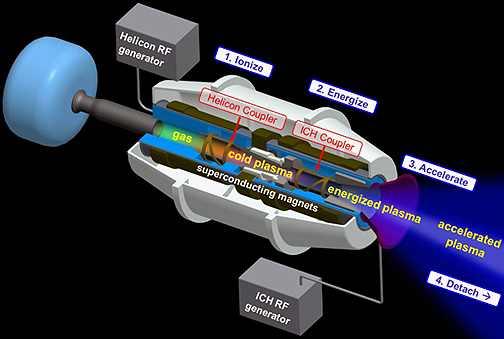
A new generation radio-frequency (RF)Power Processing Unit (PPU) for the VASIMR® engine, built for Ad Astra Rocket Company by Aethera Technologies Ltd.of Canada, has completed a full-power test in vacuum at Ad Astra’s Texas facility near Houston.
The test, conducted on January 20, involved operating the unit in hard vacuum and thermal steady-state at its full power rating of 120 kW. As part of the test, the PPU was also subjected to the magnetic field of the VASIMR engine to verify that there is no magnetic effect on the PPU performance.

The Variable Specific Impulse Magnetoplasma Rocket (VASIMR®) engine is a new type of electric thruster wherein gas, such as argon, xenon, or hydrogen, is injected into a tube surrounded by a magnet and a series of two radio wave (RF) couplers turn cold gas into superheated plasma and the rocket’s magnetic nozzle converts the plasma thermal motion into a directed jet. Illustration is courtesy of Ad Astra.
With this test, Ad Astra successfully completed one of the three remaining major technology milestones in the NextSTEP Partnership Program contract with NASA for the maturation of the VASIMR engine. With these results, the VASIMR system is now fully positioned at technology readiness level (TRL) 5; that is, all critical engine components have now been operated at full power in a relevant environment under vacuum.
A critical component of the two-stage VASIMR engine, the RF PPU provides the RF energy needed to efficiently heat the rocket’s argon propellant in the high-power second stage. A similar, lower power, RF PPU will be used in the first stage to ionize the propellant. The resulting high-temperature plasma accelerates in the magnetic nozzle to provide rocket thrust. At a maximum rated power of 120 kW and weighing only 53 kg., the VASIMR RF PPU is as much as10x lighter than that of competing electric thrusters and its advanced semiconductor-based design produces greater than 97% DC-to-RF power efficiency.
The development of the RF PPUs are supported by Ad Astra Rocket Company and the Canadian Space Agency(CSA). CSA’s support is part of a contribution agreement under the Space Technology Development Program (STDP) announced by the CSA on May 25, 2018, and expands the international dimension of the VASIMR project.
Two milestones now remain in Ad Astra’s queue and are planned for completion this spring.These involve long-duration, 100 kW firings of the VX-200SS VASIMR test article; one for 5-6 hours to demonstrate thermal control of the engine, and a second for 100 hours to estimate component life. Upon completion of these milestones, Ad Astra will move to the next technology maturation phase: the development of a TRL-6 VASIMR engine for as pacetest.
Jared Squire, Senior VP of Research, said that watching the test was like a dream, with all parameters maintaining comfortable margins. What seemed like an easy test was a testimony to the quality of the teams that developed and tested this beautiful piece of equipment.
Tim Hardy, CTO at Aethera, noted that the environmental requirements for vacuum and magnetic field were key requirements for the RF PPU and having a successful result on the first test was a big achievement for the design teams. The company is looking forward to continuing positive outcomes for Ad Astra.

